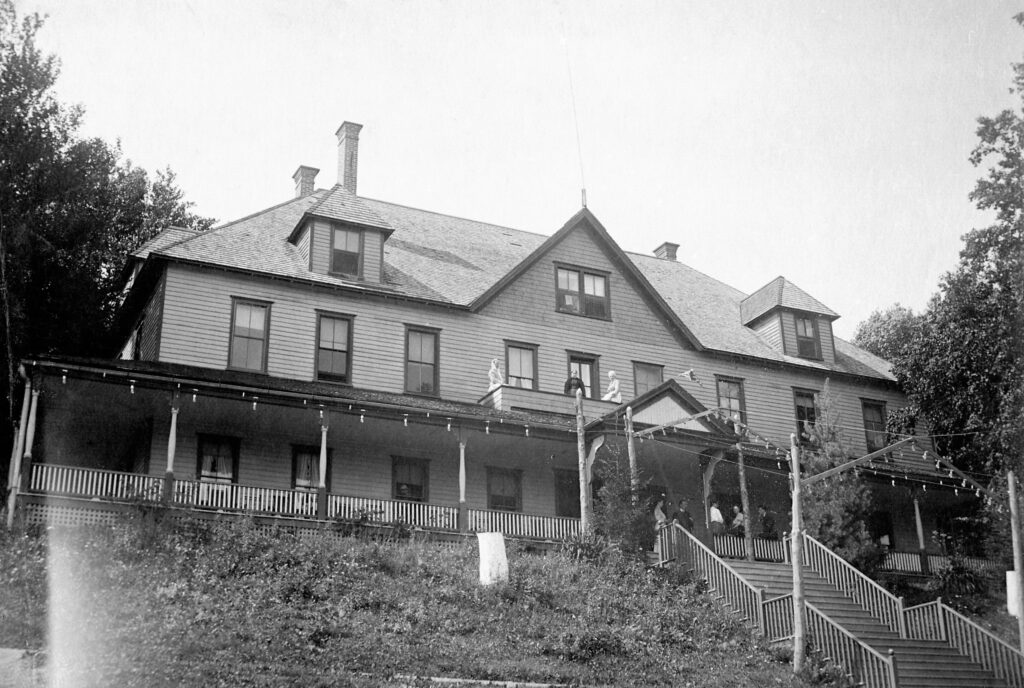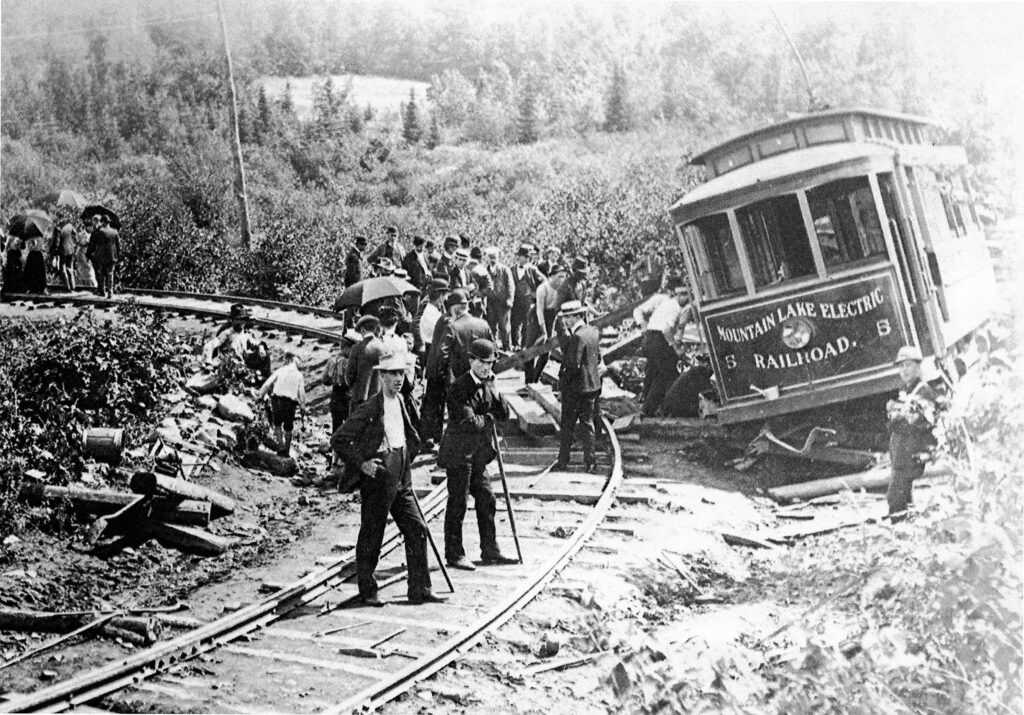The history of the Mountain Lake Electric Railroad that ran from Gloversville to Bleecker will always be dominated by the disastrous crash on July 4, 1902. A day of holiday merry-making ended in a tragedy resulting in multiple injuries and loss of life.
In March 1896, the newspaper announced that a company had been formed to build a railroad “up the mountain,” from Gloversville to Mountain Lake. Those involved were “among the prominent representatives of the largest business interests in this city and Johnstown, and are fully possessed of the energy and enterprise which is necessary for the successful completion and operation of the new road.”
It was not uncommon for railroads to create their own destinations. Not only did it encourage people to take the train and spend money on the fare, but once they arrived at these destinations, they spent money on food and entertainment. These dollars would also go to the enterprising railroad company who dreamed up and built the spot. The FJ&G RR, for example, constructed Sacandaga Park, which served tens of thousands of guests every summer and became known as the “Coney Island of the North.”

The Mountain Lake rail began at the corner of Main and Fulton in Gloversville. The ride up promised a view of the Catskill Mountains to the south and the mountains of Massachusetts and Vermont to the east, “while the general view of the Mohawk Valley and surrounding country furnishes a beautiful panorama.” The train carried riders directly to the back of the newly built Mountain Lake Hotel. It ran four double truck open cars with two GE motors of 100 horsepower each. The cars ran until 10pm each night. The Mountain Lake RR Company also owned a stone quarry, which the new rail would service. The quarry included good mountain stone and polishing marble, and plans were being discussed to connect the FJ&G RR for this purpose.

The newly constructed Mountain Lake Hotel offered live entertainment and dancing and special dinners – promising a perfect little getaway from the city not only for locals but for travelers from all over New York State.

On July 4, 1902, the park at Mountain Lake on Bleecker Mountain was packed. About 1,600 people purchased tickets for the electric trolley that would bring merry-makers up the mountain for a day of fun and relaxation. The last trolleys usually left at 10pm, but because of the scheduled fireworks, the park was open a bit later and there was a much larger crowd still at the lake by the time the display was over. A crowd of 300-400 people waited for a ride back to Gloversville.
Two cars, #1 and #5, carrying a total of 130 passengers, started their trip down the mountain five minutes apart. Car #1 left first, and on its way down it met and passed Car #4 on its way back to the resort. The conductor on Car #1, James Cameron, should have told the passing car that another was not far behind them, but he forgot. So, when Car #4 met the second car coming down the mountain, it had to back up to a siding to let #5 pass. This caused a delay and, possibly trying to make up time, Car #5 came careening down the mountain at a high rate of speed. There on the tracks in the darkness ahead of it was Car #1. Motorman on #5, William Dodge, tried to throw on the brakes (the cars were not equipped with any emergency braking system). Still, the car barreled forward. In a last-ditch attempt to avoid a collision, Dodge threw the car’s motors in reverse, blowing out the breakers in the power-house.
In the dark, warm summer night, Car #5 crashed into the back of Car #1.
The two cars continued rapidly down the track at an estimated speed of 60 MPH. Conductor Cameron and a passenger on #1 tried to activate the hand-brakes. They held, but wheels locked as the heavier Car #5 continued to push down the mountain. They were quickly approaching an S-curve at the bottom of the hill. A few passengers jumped, escaping with only minor injuries. But as the first car reached the curve, it flew off the tracks and landed on its side. During the time it was airborne, several of the passengers were thrown out of the open-air trolley and were, sadly, crushed as the car landed on top of them. Car #5 also left the tracks, but remained upright.
It took nearly two hours for power to be restored and help to arrive. Doctors and nurses from Nathan Littauer Hospital loaded the injured passengers into a car. Those who lived nearby rushed to the scene to do what they could.
A total of 14 people – 12 passengers and 2 railroad employees – died as a result of the crash, and many more sustained injuries.

An unsung hero in this tragedy was 17-year-old F. Willi Berghoff, who was thrown from one of the cars but otherwise uninjured. Having the foresight to prevent the accident from becoming even worse, he ran up the tracks in the dark and wildly waved his hat, stopping the next incoming car from driving straight into the accident.
The newspaper described the scene of the crash: “The mental torture was something terrible, and to those who were penned up in the charnel place, with the dead underneath them and the wounded among them, with no lights to show them the awful state of affairs, and the shrieks and groans of the injured and the ominous silence of the people under the car and in the creek, it is something which no lifetime will ever make them forget.” You can read more about the accident, and the experiences of the survivors, in the July 7, 1902 issue of the Gloversville Daily Leader here.
An investigation led by Coroner Robert Palmer and District Attorney Egelston ultimately found the Mountain Lake Railroad Company hired incompetent motormen. An article published in the Rome Sentinel read: “The motorman was killed in the accident, so the officials of the company must alone bear the charges of negligence . . . The financial condition of the Mountain Lake Railroad Company is such that neither the families of the dead victims of the wreck nor the injured passengers who survive can secure what it would seem they are entitled to in the way of damages, and perhaps no one will ever be criminally punished because of the awful tragedy.”

A relief fund for the victims was taken up in Gloversville, and by August 7, 1902 it reached $1,474.73. Donors included Lucius Littauer, Charles Knox, and various religious organizations, businesses, and community groups.

The railroad company never recovered from the tragic accident and loss of life that occurred on that 4th of July night. The FJ&G purchased the line in 1904 and renamed it the Adirondack Lakes Traction Co. The Mountain Lake Hotel remained in operation, but it was struck by lightning in the early morning hours of August 4, 1908 and burned to the ground. The 14 guests who were staying there at the time all escaped uninjured. A decade later, the FJ&G abandoned the line and it was sold for scrap.
Today, the 1902 disaster is the Mountain Lake Railroad’s legacy. It is the most known fact about the historic railroad. The Fulton County Historical Society’s permanent railroad exhibit includes a section on the Mountain Lake line and its fate.

